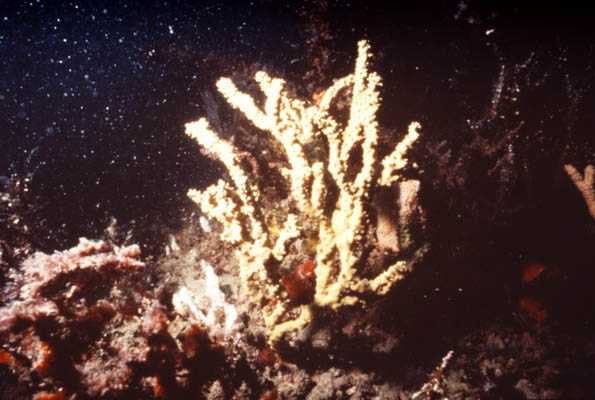Morphological description (show/hide)
| Typically stipitate, moderately short cylindrical, to long thick stalk (3-21 mm basal diameter) with a basal attachment encrusting on the substrate. The basal attachment is never rhizomous. Branches are thinly cylindrical, rarely anastomosing, and branching is mostly irregular, digitate, bushy, occasionally regular, multiplanar, rarely flagelliform. Total length and branch diameter is variable (50-460 mm, 2-22 mm, respectively). | | Highly variable pigmentation, ranging from ma | | Exhalent pores are mostly not visible optically, but occasionally they can be seen on the distal ends of branches, surrounded by surface conules, and occasionally scattered along the entire | | Texture is firm, barely compressible, branches are rubbery whereas the stalk is more rigid. The surface has characteristic regularly (less often irregularly) scattered surface conules. Conules are tapering, distally rounded or blunt, and are absent from the basal and distal extremities (1.8-6.2 mm maximum basal diameter). | | The surface is dense, entirely opaque in life. | | The dermal skeleton consists of a very dense, continuous palisade of small ectosomal auxiliary subtylostyles, arranged in dermal brushes, and a thick subectosomal region immediately below. In the subectosomal region, larger subectosomal auxiliary megascleres form plumose subdermal brushes, which pierce the ectosome and often obscure true ectosomal brushes, the subectosomal, non-fibrous component of the skeleton arises from ultimate choanosomal fibres and in places those tracts are intermingled with tufts of principal choanosomal megascleres (which echinate the peripheral fibres). Choanosomal megascleres do not extend into the ectosomal region. Ectosomal and subectosomal spongin is usually heavily pigmented. | | Fibres are heavily anastomosing, and heavily invested with spongin (50-125 ï¾µm diameter). They are typically not divided into primary or secondary elements, and form a relatively irregular, close-meshed reticulation. Meshes are oval to eliptical (100-350 ï¾µm diameter). All fibres are cored by multispicular tracts of subectosomal auxiliary megascleres, occupying 60-80% of fibre diameter. Principal spicules are rare or uncommon, usually occurring only at fibre nodes, echinating peripheral fibres singly or in bundles, and only very rarely are they seen coring fibres. Fibres are also echinated by acanthostyles in highly variable concentrations, with particularly heavy concentrations on the peripheral fibres. Spongin of the mesohyl matrix is usually abundant, lightly pigmented only, slightly granular, lining fibres and oval or eliptical choanocyte chambers (40-170 ï¾µm diameter). Extra-fibre megascleres are usually abundant, identical to (subectosomal auxiliary) megascleres coring the fibres , organized into plumose tracts subdermally or disorganized in the deeper regions of the choanosome, and they are occassionally absent from deeper regions of the sponge altogether. | | Choanosomal principal styles-subtylostyles are uncommon to rare in most specimens, occurring predominantly as echinating spicules on fibres and fibre nodes, in bundles or singly, and only very rarely are they found coring fibres. They are mostly short, stout, slightly curved at the centre or near the base, occasionally they are straight, with non-tylote or less frequently very slightly subtylote bases. Spicules are smooth or very exceptionally they may have minutely microspined bases, with abruptly to sharply-pointed points. Length 121-(202.7)-300.5 ï¾µm, width 5-(14.4)-24 ï¾µm. Subectosomal auxiliary megascleres are distributed throughout the choanosome and subectosomal regions, forming ascending plumose tracts, coring fibres, or distributed in halichondrioid fashion between the fibres. They consist of straight to slightly basally curved subtylostyles in equal proportions, with prominent subtylote swelling. Bases are typically microspined, but are occasionally smooth, and points taper to sharp points. Length 127-(258.4)-386.9 ï¾µm, width 1.1-(8.2)-20.1 ï¾µm. Ectosomal auxiliary megascleres are restricted to the plumose brushes. They are morphologically similar to subectosomal spicules, but are markedly shorter, thinner and invariably straight. Typically they have microspined bases but that character varies between specimens. Length 44.8-(114.6)-230 ï¾µm, width 1.1-(3.8)-10.1 ï¾µm. Acanthostyles echinate fibres in variable densities, usually they are very abundant on peripheral fibres. They have a characteristic subtylote and spined basal swelling, and a virtually aspinose | | Palmate isochelae are scattered throughout the mesohyl matrix without apparent order, but occasionally they are seen lining choanocyte chambers. There are two size categories, both are relatively abundant, and both size categories have representatives with twisted shafts (heads at right angles to each other), but twisted examples of the smaller form are more abundant. Length I 7.9-(12.1)-19.9 ï¾µm, length II 0.5-(5.8)-10 ï¾µm. Toxas are variable in abundance, mostly uncommon, distributed throughout the choanosomal and subectosomal spongin. Toxa geometry varies from short, thin, generously curved centrally and with reflexed tips, to long, thin almost straight with little central or distal flexion. Length 3.2-(54.9)-344.6 ï¾µm, width 0.3-(1.4)-4.1 ï¾µm. |
|

